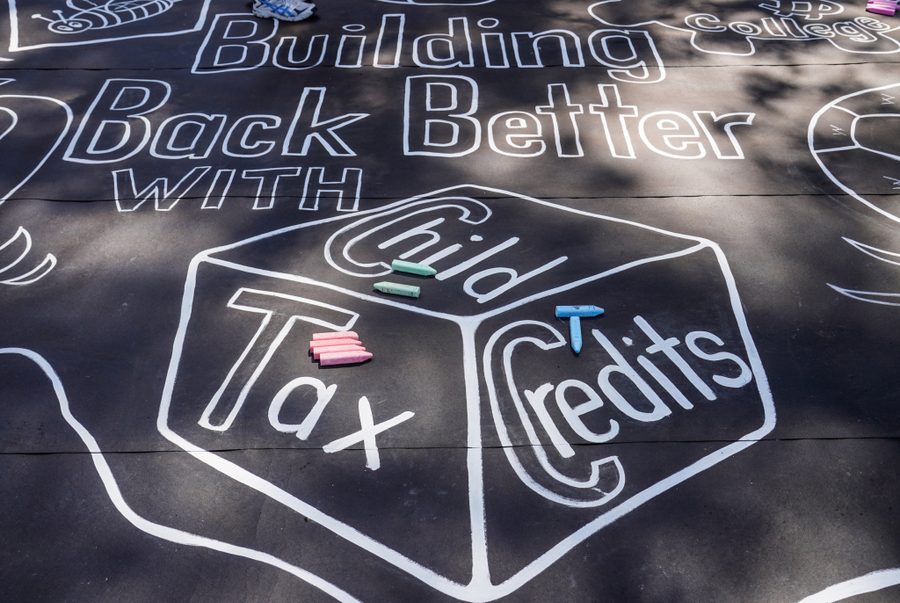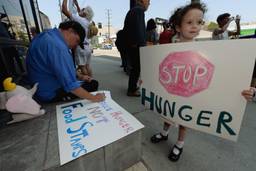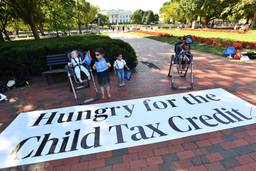How Targeting Programs to Poor People Leaves Out Poor People
Some centrist Democrats are pushing to make the expanded Child Tax Credit means-tested. In practice, that often means restricting benefits for the very people who need it most.
Jim Pugh

Less than one year ago, the United States government enacted one of the most effective anti-poverty programs in modern history. The Child Tax Credit (CTC), originally established in 1997, was expanded through the American Rescue Plan to provide families with children substantially larger payments, delivered monthly, while making low-income families eligible for the full benefits. This expansion changed the face of child poverty in the United States, lifting over 4 million children above the poverty line—a decrease in poverty of more than 40% — and decreasing food insufficiency for families with children by an estimated 26%.
Unfortunately, despite its transformative impact, the expansion of the CTC is now at risk of being lost. President Biden’s omnibus Build Back Better (BBB) legislation was intended to make the changes permanent, but blanket Republican opposition and concerns around cost from some centrist Democrats have now put the program into jeopardy. As negotiations continue around the policy, one proposal that’s reportedly gaining traction is to lower the eligibility income cap for the credit, making it available only to families earning less than $75,000. This would change the expanded CTC from a nearly universal program to one targeted to lower-income Americans.
If your priority is to lift children out of poverty, this may seem like a very reasonable change. Poor families remain eligible for the credit, and the lower price tag makes current negotiations easier and may help keep the program off the chopping block in the future. However, there’s a risk that by making the expanded CTC a more means-tested program, fewer poor children will end up receiving the support.
While targeting programs seems like an efficient way to allocate resources, these programs often struggle with lower “take-up rates” than those that are more universal. Take-up rate is the percentage of families eligible for a program that actually receive the benefit, and it is often far below 100% — Temporary Assistance for Needy Families (TANF), the United States’ main cash welfare program, had an estimated 2016 take-up rate of only 24.9%. In 2019, the UK think tank Development Pathways conducted an analysis of social programs around the world, looking both at how specifically targeted those programs were and at their respective take-up rates. The results were stark: for highly targeted programs, at most 56% and as low as 3% of the intended populations actually received the benefits. In contrast, more universal programs had a far higher take-up rate, exceeding 90% in some cases.
To understand this discrepancy between targeted and universal programs, we need to consider the possible reasons why an eligible person might miss out on benefits. The person might not know about a program; they might know about a program but choose not to apply; or they might try to apply for a program but be unable to successfully enroll. All three of these reasons can make a difference in take-up when comparing targeted and universal programs.
Universal programs tend to be better known than targeted ones; when everyone is eligible, the program is more likely to come up in conversations and to be covered more often in media reporting. A good example is the set of cash-based support programs enacted by the American Rescue Plan, which included stimulus checks for most Americans as well as programs to provide rental assistance and Emergency Broadband Benefit (EBB) for low-income people. Comparing the news coverage of these three programs in 2021 using Google Trends, stimulus checks had three times the coverage of rental assistance, and EBB wasn’t mentioned enough to be measured. If programs aren’t being discussed or covered by the media, people often won’t hear about them, or know to apply — as of October 2021, only one in five eligible Americans had enrolled in EBB.
How the public perceives a benefits program may vary significantly depending on whether the program is more universal or more targeted to low-income people. More universal programs tend to be viewed as public entitlements, which are generally perceived in either a positive or neutral light, while targeted programs are often seen as welfare, which carries a heavy stigma. The racist myth of the welfare queen has long shaped Americans’ perception of welfare recipients, creating an impression that people enrolled in the programs are lazy or incapable, regardless of substantial evidence to the contrary. This stigma often acts as a disincentive for people to enroll, both due to fears about how others will view them and from having internalized the stigmatized view of the program. In a 2021 study by researchers at the University of California Berkeley, people at risk of eviction were significantly more likely to apply for emergency rental assistance if they first received a de-stigmatizing message about the program, showing that stigma was acting a barrier to enrollment.
If people have heard about a program and want to enroll, they still need to successfully complete the application process. While applying can be a challenge for any government program, this is particularly true for programs targeted at low-income populations, which are susceptible to added administrative burden, which can make the process so difficult, demeaning and time consuming that applicants eventually give up trying. Low-income families are often the most strapped for time, trying to juggle multiple jobs and childcare, and the time tax imposed by these programs can effectively prevent them from completing the enrollment process.
Together, these dynamics offer an explanation for the sharp discrepancy observed in take-up rates between universal and targeted programs — and show why lowering the income cap for the Child Tax Credit carries a risk of leaving out poor families. Even when the nearly-universal credit was offered last year, lack of awareness was an obstacle to getting low-income families to enroll, and the issue will become that much more acute if the program becomes more targeted.
Political negotiations are challenging, and if it comes down to a question of lowering the income cap or ending the expanded CTC for good — which would plunge four million kids back into poverty — the choice is obvious. But if we want to help as many struggling families as possible, we should fight not just to renew the expanded Child Tax Credit, but to make it a more universal program.




